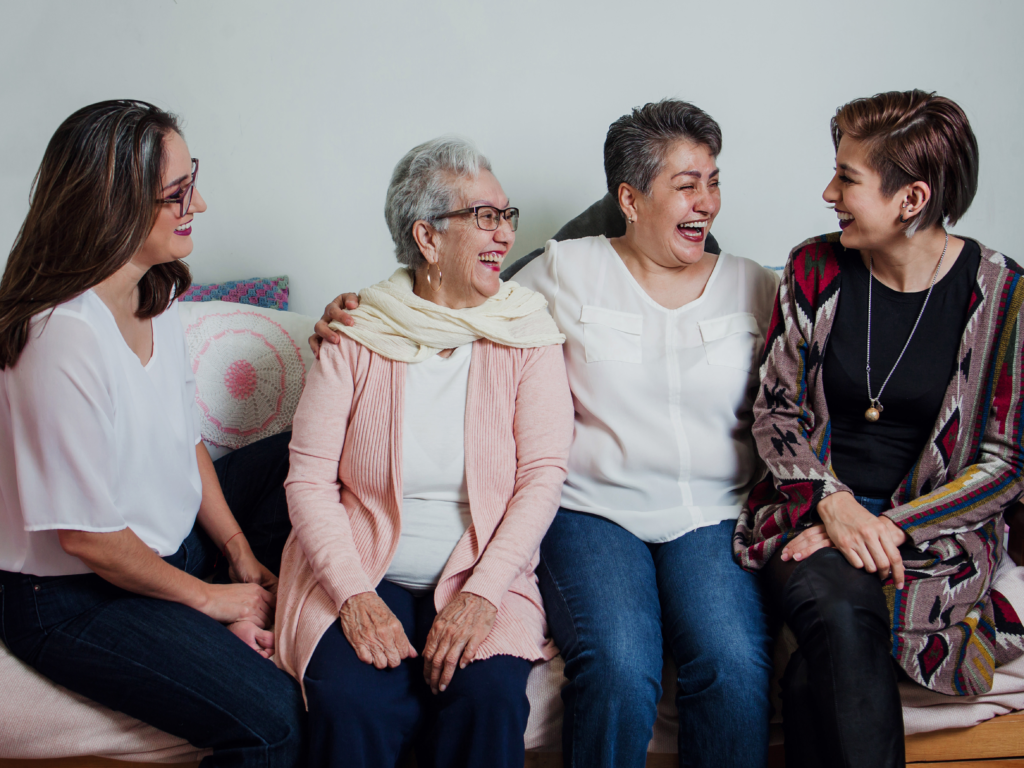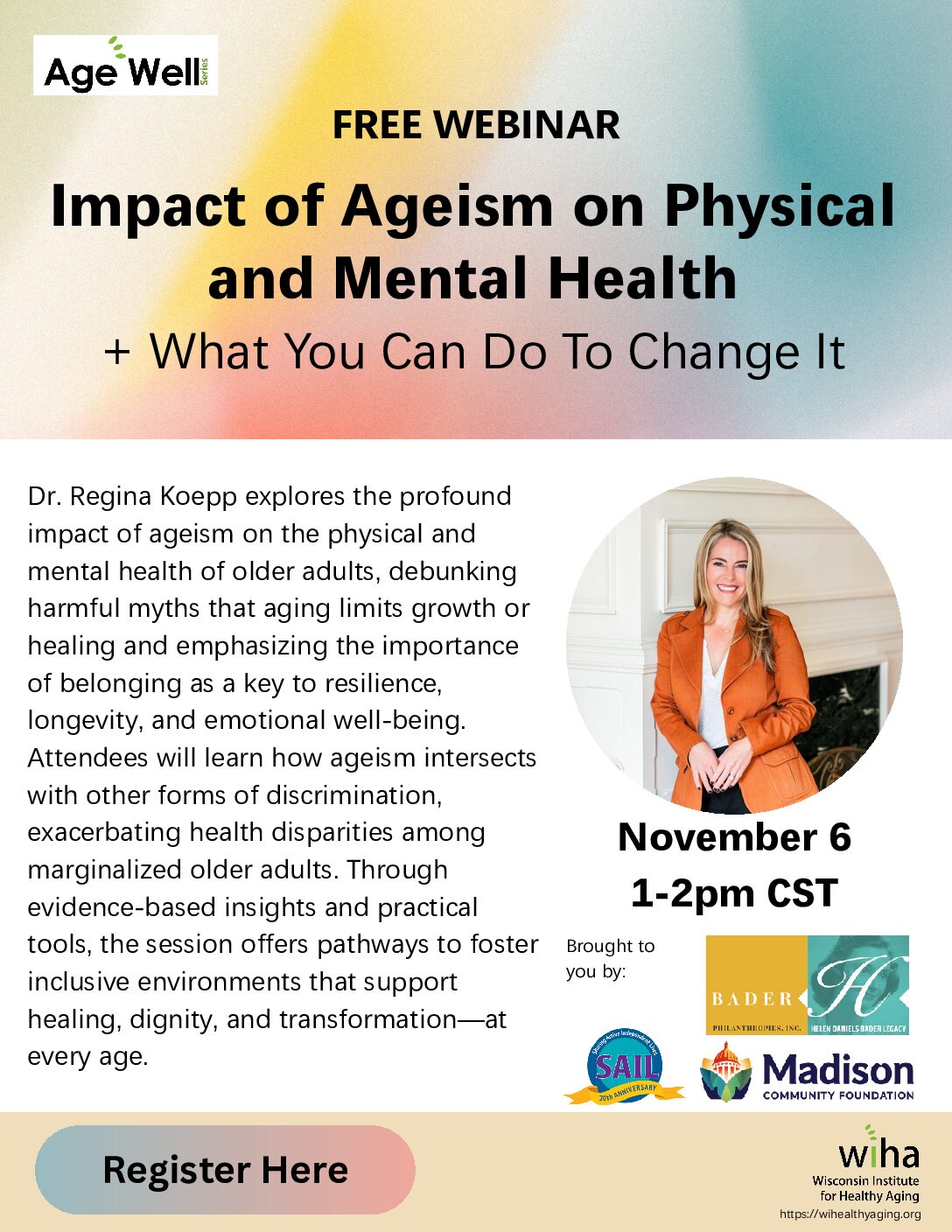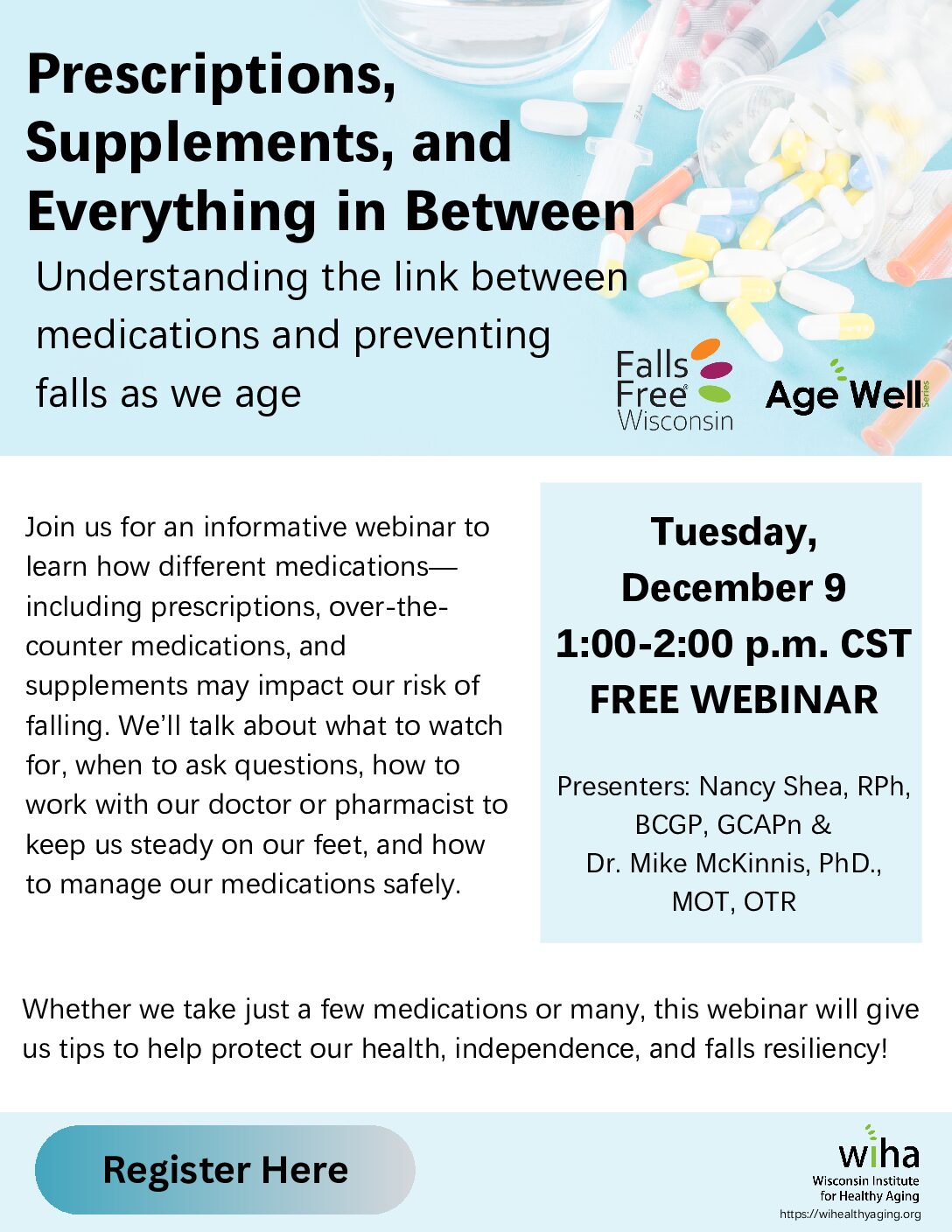
Age Well with WIHA
A newsletter from the Wisconsin Institute for Healthy Aging
Age Well with WIHA: November/December 2025
WIHA’s newsletter is published bi-monthly and sent by email. View the email newsletter online or read the full stories below. Don’t forget to subscribe!
The Power of Social Connection: Why It Matters for Everyone
Staying connected with others is one of the most powerful ways to stay healthy and happy—regardless of age. Strong social connections helps us feel valued, supported, and part of our community. When we spend time with others, share experiences, or even check in with a friend, we’re doing something that’s good for our minds, bodies, and hearts.
Research shows that feeling connected can lower stress, boost memory, and even support physical health. People who have strong social ties tend to live longer, recover faster from illness, and have a greater sense of purpose. But connection isn’t just about avoiding loneliness—it’s about belonging, contributing, and continuing to grow at every stage of life.
That’s why the Wisconsin Coalition for Social Connection (WCSC) is working to make sure everyone in Wisconsin has opportunities to connect. The WCSC brings together organizations, communities, and individuals to raise awareness about the importance of social connection and create welcoming spaces where people can build meaningful relationships.
This November, WCSC invites everyone to take part in Social Connection Awareness Week—a time to celebrate the many ways we can strengthen community bonds. Whether it’s calling a neighbor, joining a club, or volunteering for a local cause, every small action helps build a more connected Wisconsin. Check out the 2026 Bingo Card.
Let’s reframe how we think about growing older. Instead of seeing aging as a time of loss, we can recognize it as a time of connection, purpose, and contribution. Each of us has something valuable to share—and when we come together, we all thrive.
Learn more about the coalition and how you can get involved at:
Understanding Falls and Medications: What Every Adult Should Know
As we age, staying steady on our feet becomes more important — and more challenging. One of the biggest risks that older adults face is falling. Falls can lead to serious injuries, loss of independence, or even death. The good news is: many falls are preventable, especially when we pay careful attention to what medicines we use.
How medicine use raises fall risk
An article from the Journal of American Medical Association explains that certain prescription drugs, known as fall risk–increasing drugs (FRIDs), make falls more likely. These drugs can slow your reflexes, make you dizzy, blur your vision, or weaken balance.
Here are a few examples of FRIDs that are especially concerning:
- Opioids (for pain relief)
- Benzodiazepines (for anxiety or sleep)
- Gabapentinoids (used for nerve pain, sometimes for other pain)
- Antidepressants
Many older adults take multiple prescriptions. The article notes that 90% of adults over age 65 take at least one medication, 43% take multiple ones, and 45% take medications that might be risky.
In fact, research has found that 65% to 93% of older adults who are injured in falls were taking at least one FRID at the time.
Why are falls increasing over time?
Even though people today are not necessarily more frail or more likely to live alone than in the past, deaths from falls have more than tripled over the past 30 years.
One likely reason: the soaring use of medications that affect the brain and nervous system. Because medications are changeable (unlike age or eyesight), experts say doctors and health systems must do a better job reviewing prescriptions.
What you can do right now
- Talk with your doctor or pharmacist. Ask whether any of your medications are on the FRID list. Discuss safer alternatives or dose reductions. Bring the Medication Record Card with you to a health care provider.
- Do a “medication review” regularly. Especially when a new drug is added, have your medications looked at in combination.
- Watch for symptoms. Dizziness, confusion, sleepiness, or trouble walking may be signs that a drug is causing trouble.
- Strengthen your body. Balance training, muscle strengthening, and working with physical therapy can offset some risks.
- Make your home safer. Remove trip hazards, add grab bars, improve lighting—and do this in conjunction with careful medicine use.
Falls Free Wisconsin: A partner in prevention
In Wisconsin, Falls Free Wisconsin (FFWI) is a key organization focused on preventing falls and promoting safer aging. FFWI works on policies, education, and community programs to help older adults stay steady and confident.
FFWI supports efforts to raise awareness, help communities assess fall risk, and encourage self-management for falls prevention. They are a valuable resource if you or someone you know wants to dig deeper into fall prevention in every part of life.
Falls are not just an inevitable part of getting older — they are a risk we can reduce. By combining smart medicine use, community support, and actions grounded in reframing aging, we can stay more active, more independent, and safer for many years.
Join us for the December Age Well Series on Prescriptions, Supplements, and Everything in Between to learn more about the link between medications and falls!
Empowering Health, Independence, and Connection: The Work of the Wisconsin Institute for Healthy Aging
At WIHA, our mission is simple but powerful: to improve the health and well-being of all of us as we age. For the past 15 years, WIHA has been dedicated to offering programs, training, and resources that support independence, prevent falls, and foster social connection—so that all Wisconsinites can thrive as we grow older.
Through evidence-based programs like Stepping On, Living Well with Chronic Conditions, and Mind Over Matter, WIHA helps us reduce fall risk, manage chronic conditions, and make healthy choices that enhance quality of life. (See our 2024 By-the-Numbers Report.) Our programs don’t just focus on physical health—they also provide opportunities for social engagement, peer support, and community involvement, recognizing that connection is a cornerstone of well-being.
But WIHA’s impact goes beyond the participants. We train and support hundreds of community professionals and volunteers across the state, ensuring that these life-changing programs reach even the most rural and underserved areas. Every session taught, every facilitator trained, and every participant supported is a step toward a safer, healthier Wisconsin for all of us.
The benefits of our work are real and measurable: fewer falls, greater confidence, improved self-management, and enhanced social connection. These outcomes mean that we can maintain our independence longer, stay active, and continue to contribute to our families and communities.
As we look toward the end of the year, WIHA is inviting friends, supporters, and community members to help us expand this critical work. Your generosity allows us to reach more people, train more facilitators, and ensure that everyone in Wisconsin has the opportunity to age well. Together, we can help all of us stay safe, active, and connected—because everyone deserves a healthy, independent, and fulfilling life.
Stay tuned for our Giving Campaign this December, and join us in making a difference that truly lasts a lifetime.
Find a Workshop
Take charge of your health by taking a WIHA workshop. We offer in-person and virtual (online or by phone) programs that give you the tools to age well. Getting started is easy – simply click the link below.
Enjoyed the newsletter? Subscribe today!
In this Issue
Featured Program: Living Well with Chronic Conditions
Taking care of yourself is an important part of life. If an ongoing health problem such as arthritis, cancer, heart disease, high blood pressure, high cholesterol, obesity, or another health complication has kept you from activities that you enjoy, you are not alone. In fact, nearly 95% percent of older adults have at least one chronic condition, and nearly 80% have two or more. Living Well with Chronic Conditions (or Living Well) is a fun, interactive, 6-session workshop that helps you take charge, feel better, and improve your health. Living Well is an evidence-based self-management program originally developed at Standford University.
Research: Research from the Self-Management Resource Center has found that Living Well improves health behaviors such as exercise, coping, and communication with health care professionals. In addition, it improves health status and quality of life. Studies also show that Living Well helps to keep you out of the emergency room (27% fewer emergency room visits) and out of the hospital (22% fewer hospitalizations).
Who is it for: Living Well is for adults of all ages. The focus is on helping you to feel better, have more control, and do the things you enjoy doing.
How to participate: You can participate in Living Well with Chronic Conditions in-person, virtually, or by phone. The workshop is offered in both English and Spanish. To find a workshop, visit our Find a Workshop page.
“By us sharing our experiences and being able to connect participants with health care providers that have helped us in the past. We are always sharing with others and helping get other people involved in these programs because we know it can help them”
Jim C.
Vilas County, WI





